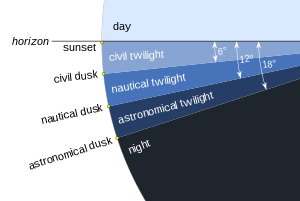


Twilight is sunlight illumination produced by diffuse sky radiation when the Sun is below the horizon as sunlight from the upper atmosphere is scattered in a way that illuminates both the Earth's lower atmosphere and also the Earth's surface. "Twilight" can also refer to the periods when this illumination occurs.[2]
The lower the Sun is beneath the horizon, the dimmer the sky (other factors such as atmospheric conditions being equal). When the Sun reaches 18° below the horizon, the illumination emanating from the sky is nearly zero, and evening twilight becomes nighttime. When the Sun approaches re-emergence, reaching 18° below the horizon, nighttime becomes morning twilight. Owing to its distinctive quality, primarily the absence of shadows and the appearance of objects silhouetted against the lit sky, twilight has long been popular with photographers and painters, who often refer to it as the blue hour, after the French expression l'heure bleue.
By analogy with evening twilight, the word twilight is also sometimes used metaphorically, to imply that something is losing strength and approaching its end. For example, very old people may be said to be "in the twilight of their lives". The collateral adjective for twilight is crepuscular, which may be used to describe the behavior of animals that are most active during this period.
- ^ Van Flandern, T.; K. Pulkkinen (1980). "Low precision formulae for planetary positions". Astrophysical Journal Supplement Series. 31 (3): 391. Bibcode:1979ApJS...41..391V. doi:10.1086/190623.
- ^ "Definitions from the US Astronomical Applications Dept". USNO. Archived from the original on 2019-09-27. Retrieved 2011-07-22.